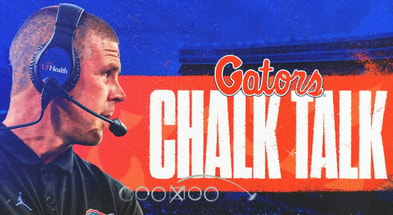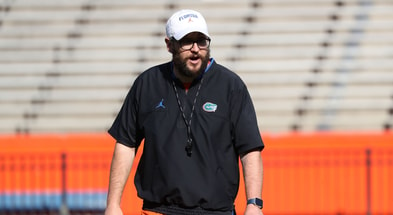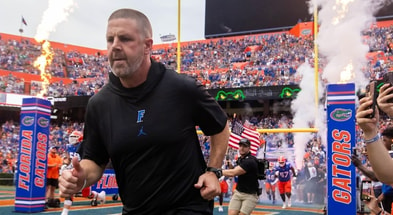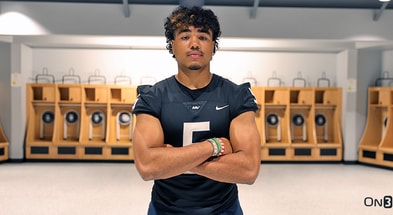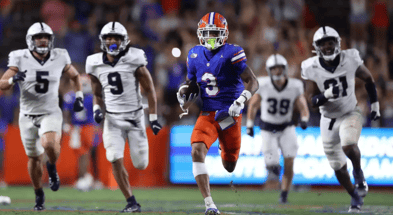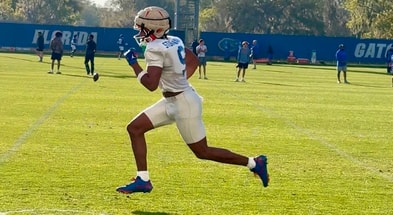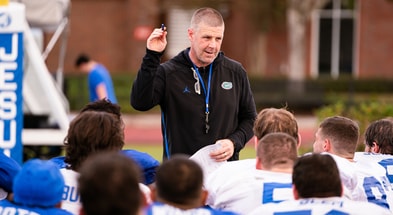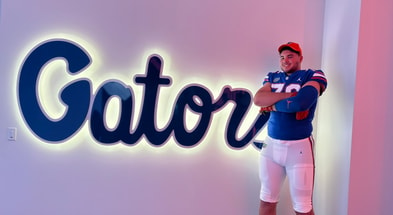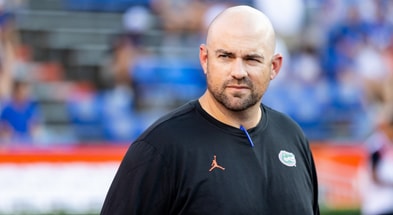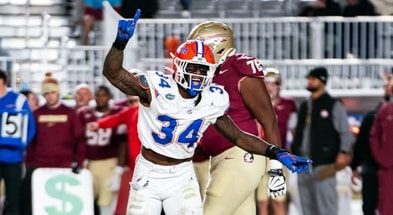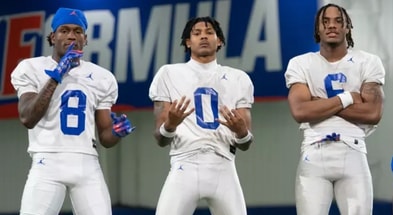Heavener Center provides wow factor, ‘50-year fix’ for Florida football

GAINESVILLE, Fla. — As Florida coach Billy Napier and his staff cleaned out their offices this week, they could throw away the renderings of The James W. “Bill” Heavener Football Training Center shown to recruits for years.
The real thing is here.
The Gators check out of their team hotel Sunday and move into their new 142,000-foot home with a $85 million price tag.
“It screams commitment,” Napier said this week. “A lot of time, energy and certainly investment from a lot of our supporters have made it to really improve our facility. Everyone wants to talk about recruiting when it comes to the facility but I think it’s more important to our player experience.”
For the UF football program, the standalone facility will have as much impact on the field as it does off the field. It provides the players with a one-stop shop for their nutrition, training, recovery and even entertainment needs, highlighted by state-of-the-art lockers as well as a dining hall and lounge for all student-athletes.
The lounge space is in the front lower quadrant of the building and will be inviting for players and recruits alike. Making a strong first impression on the latter is key.
“The recruiting piece, to me, the most important thing,” Florida athletic director Scott Stricklin told Gators Online. “There’s a reason why a bank lobby is really nice and why churches build really nice facilities. It’s because that’s a representation of the quality of what’s going on at those institutions. The facility says a lot about what is important to this enterprise.
“And the few years, we have not been able to have our facility really deliver a message about how important football is to the University of Florida. And starting Sunday, when you walk into the Heavener Center, it’s going to be obvious that this is an enterprise that’s very important to the University of Florida and the UAA. And it’s going to be a tangible embodiment of that commitment.”
Sunday will mark the first time players have walked through the building in five months, said Chip Howard, Florida’s executive associate athletics director for internal affairs. He oversees operations and facilities at UF and was the point person on this project, which began in 2016.
“Once we get a chance on Sunday night to see the players’ reaction, that’s when it really hits you,” Howard told Gators Online. “It’s kind of like when you build a house. When it’s studs it’s one thing, but when you see the granite countertops and all the finishes, it blows you away. I think that’s what they’re going to be excited about. And the fact that they’ve got a new home that’s going to be the nicest in the country.
“When you see what the players’ reaction is and the next day see them actually utilizing the space, that makes everything worthwhile. The process of taking six years to get to this point, it took a little longer obviously because we totally changed locations, but it’s going to be worth it. This is the right building. Why do a building that’s not going to be quite right? This is the best in the business.”
A 50-year fix
Florida’s football headquarters was originally designed for the north side of Percy Beard Track on 2nd Avenue. At the time, the UAA was also planning to upgrade the now demolished McKethan Stadium.
The first standalone plan had a $50-60 million price tag — more than $25M less than the new facility — and was going to be a vertical building with three or four floors. Stricklin admits both initial facility plans for baseball and football were short-term fixes that didn’t cut the mustard.
When Howard suggested building a new baseball stadium, the $65 million Condron Family Ballpark, and moving the football headquarters to where McKethan was located, the UAA finally had its long-term solution. That also came with an additional $90 million in facility expenses.
“It’s a lot of money you’re investing as a program. It needs to be really impactful and get people excited. And we wanted something that’s going to be there a long, long time,” Stricklin said. “Candidly, the original plan to put the football building on 2nd Avenue and put some money into McKethan made sense from one standpoint. You wouldn’t be spending as much money. We could have done it quicker.
“But in both of those situations, it wasn’t going to be impactful enough. In about 5-10 years, we’d be trying to figure out what to do to make the new situations better. So by stepping back, taking a little more time and spending more money, both of those programs are set for generations. So it’s a 50-year fix, it’s not a five-year fix.”
Switching locations wasn’t the only time Florida altered its football headquarters. Over the past six months, Napier and director of football operations Joshua Thompson have worked closely with Howard to make modifications and put their mark on the facility.
A total of 39 change orders were submitted, some which required knocking down walls and creating different office spaces. The UAA was able to use money saved early in the process from underbid orders for materials — before prices went through the roof — to accommodate Napier’s requests in its original budget.
His most notable stamp on the standalone is the graphics package, which he completely redesigned.
“From a graphic standpoint, we were able to make some significant changes that he wanted to make and that’s really his blueprint all over it,” Howard said. “When the players come through the door from the all-athlete area and walk down to the locker room, there’s a really cool hallway there that is illuminated and has different colors. It really pops. And then we have some really large backlit graphics in the weight room. That whole area is incredible.”
What will be some of the additional “wow” factors? The locker room really impressed Gator Great and Florida football color analyst Shane Matthews, who visited the facility earlier this week.
“The locker room is ridiculous. It’s got these zero gravity chairs that fold into a bed, each locker,” Matthews said. “I went through it the other day and it is just phenomenal. You’re almost jealous.”
Stricklin added, “The locker room is something that will be really special for them. We’ve been careful about not showing a lot of pictures of that. I think we have something unique there. No one else has it, with the way we designed that thing and giving each player a lot of individual space. I think they’re going to be blown away by that.”
When Matthews played for the Gators in the early 1990’s, Yon Hall served as the dormitory for the male athletes. It housed approximately 112 rooms inside Ben Hill Griffin Stadium and was closed in 1995.
“We had Yon Hall, which was a dump. But everything was right there. You walk down two flights, you eat. You walk down three flights, you’re in the locker room. It was convenient, but that was about it,” Matthews recalled.
“This new building is going to be perfect and it’s something we’ve needed for a long time. Everybody has been looking at pictures on a wall of what it’s going to look like. Now they’re going to be able to actually walk in it.”
Top 10
- 1Breaking
Johni Broome
Auburn star leaves game vs. Michigan State
- 2New
Final Four game times
Tip times, TV announced
- 3Hot
Baseball Top 25 projection
More shakeup coming
- 4
Houston vs. Duke odds
Final Four line goes up during Houston vs. UT
- 5
Jay Bilas calls out
Reaction to Willard hiring
Get the On3 Top 10 to your inbox every morning
By clicking "Subscribe to Newsletter", I agree to On3's Privacy Notice, Terms, and use of my personal information described therein.
For Stricklin, who built a standalone complex as the AD at Mississippi State that was half the size of Florida’s facility, the Heavener Center has three features that stand out.
He and Howard mentioned the player lounge, featuring a huge banner with all of Florida’s conference and national championships, and the new strength and conditioning space, which connects the weight room to the indoor practice facility with big glass doors.
Another unique area, according to Stricklin, is a multipurpose room on the second level with a huge video wall and a carpet with hash marks and a 15-yard field area.
“It’s literally on the same level right next to the player meeting rooms. So, if a coach wants to take them out and look at it on the big board and do a walkthrough, he can go in there with his guys and say, ‘OK, get where you’re supposed to be against this front.’ There’s a lot of really cool, well thought out efficiencies like that,” Stricklin said.
“Everywhere people go when they walk through it, there’s going to be something that draws your attention. There’s going to be something that makes you go, ‘Wow’. There’s going to be a graphic, there’s going to be an amenity or a notable feature. The designers and everybody who worked on that project really put a lot of effort into the details and that’s going to really pay a lot of dividends.”
Every bell, every whistle
Aside from the wow factor, both Howard and Stricklin said what players will ultimately enjoy and benefit from most are the efficiencies of having everything in a central location. Not having to leave the facility for other team activities will make a big difference.
“Time is of the essence and I think the new facility is going to create more efficiency for everyone involved,” Napier said.
In years past, players always had to walk/drive from the locker room or weight room inside the stadium to the practice field or to the dining hall. That was extra miles on their legs. And if they wanted to hang out by the pool or play a pickup basketball game during their down time, they had to go to the nearest apartment or condo.
Players can now enjoy the luxury of having all those amenities in one place, including a cabana-style pool, an outdoor basketball court and a barbershop. This will create an environment that players want to be around, which should help foster team chemistry.
“It promotes more connection, obviously for football,” Stricklin said. “But because of the dining hall and that outdoor space for all the athletes, I think it’s going to spread beyond football. And this athletic department has had a lot of really special success when there’s a synergy between the programs. You look at when Billy [Donovan] was winning his titles and football was winning their titles, there was a synergy that really lifts up the whole program and I think having all the athletes right there has a chance to do that as well.”
The Heavener Center also features a rehydration room and a rehabilitation facility that includes a cryotherapy chamber, two HydroWorx pools, a 50-foot plunge pool, a float tank, a sauna and a steam room.
“To me, what makes this building special is the efficiency for the kids,” Howard said. “How much time they’re going to save just by everything being within 75 feet of each other. At the facility you can eat, you can socialize, you can study if you want, you can relax in the game room, you can swim in the pool or play hoops, you can get treatment, you can meet with your coaches, you can practice, you can park, you can do everything right there. They only need to leave to go to class or go home.”
Now that the Heavener Center is officially open, the UAA has completed the third and final phase of its facilities master plan.
The first phase began in 2015 with the $15 million indoor practice facility, followed in 2016 by the Otis Hawkins Center ($25M) and Exactech Arena renovation ($64.5M). The second phase entailed the 2019 renovation to softball’s Katie Seashole Pressly Stadium ($15M) and the Condron Ballpark ($65M).
Where does the new $85M football headquarters put Florida in the facility arms race?
“I’m sure there’s some really nice ones out there. I don’t think anyone is going to have anything nicer,” Stricklin said. “This is going to have every bell, every whistle. There are no gold-plated toilets, but there are a lot of really nice features. We tried to invest the money in a way that would make a difference for the players and the coaches and what their experience is. There’s a lot of flashy, cool things in there, but we weren’t wasteful about it.
“And some of these facilities you look at, you get a sense people are doing stuff just to try and be noticed or just for the recruiting impact of one weekend. I don’t know how many kids are really making decisions based on that stuff. Obviously, we thought a lot about recruiting as we were going through this process, and we ended up with a facility that’s going to serve the Gators really well for a long, long time.”




